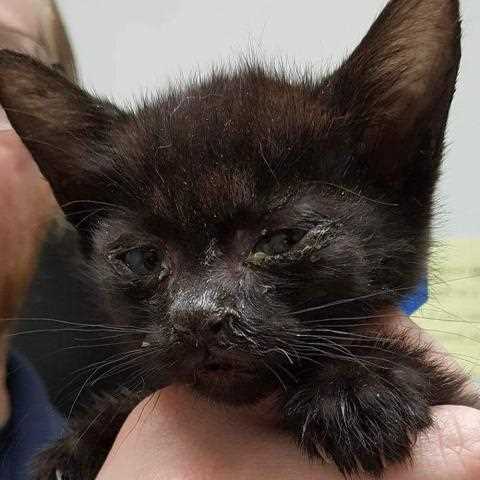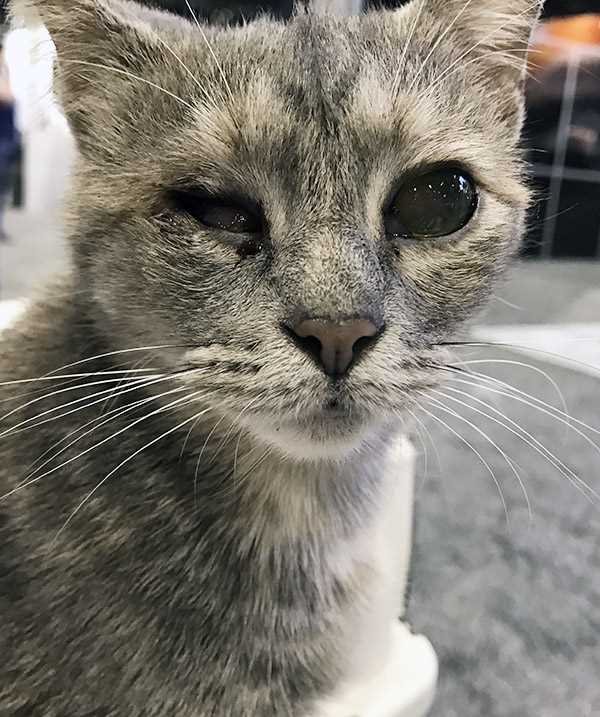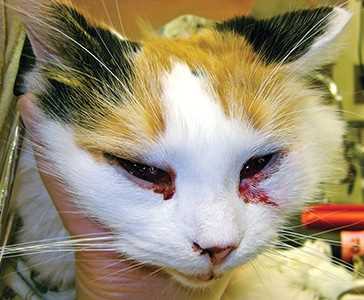It’s a common concern among pet owners that respiratory infections can spread between different species. The short answer is that these infections, particularly viral and bacterial ones, are generally species-specific. This means that the likelihood of a Scottish Fold feline sharing a respiratory virus with a canine counterpart is quite low.
However, close contact can lead to various health issues. If an infected animal sneezes or coughs, droplets can linger in the air or settle on surfaces, potentially affecting other animals in the vicinity. Keeping a watchful eye on both your furry friends is crucial during flu season or when one shows signs of illness.
Regular veterinary check-ups and vaccinations play an essential role in maintaining their health. Ensuring that both pets are up-to-date on their vaccines can significantly reduce the risk of respiratory infections. If one of your companions shows signs of illness–like coughing, sneezing, or lethargy–consult your veterinarian for appropriate care and advice.
Can Felines Transmit Respiratory Infections to Canines?
It’s unlikely for felines to pass respiratory infections to canines. These two species have distinct pathogens that typically do not cross between them. Most respiratory ailments in canines stem from specific viruses or bacteria such as Bordetella bronchiseptica and parainfluenza, which are not associated with feline illnesses.
Precautions for Pet Owners
Maintaining a clean environment is key. Regularly disinfect shared spaces and ensure both species receive appropriate vaccinations. If a feline exhibits signs of illness, such as coughing or sneezing, it’s wise to minimize contact with other pets until a veterinarian can assess the situation.
Signs of Respiratory Issues
Watch for symptoms like coughing, nasal discharge, or lethargy in both species. If a canine shows these signs after being around a sick feline, consult a veterinarian. Early intervention is beneficial for recovery.
Understanding URI Transmission Between Species
Transmission of respiratory infections among pets is a topic that intrigues many. Interspecies transfer is uncommon but not impossible. Infectious agents can sometimes cross species barriers, although the likelihood varies significantly based on the pathogens involved.
Factors Influencing Transmission
Several aspects determine whether a respiratory infection can transfer between different species. The type of pathogen plays a crucial role; some viruses and bacteria are specific to certain animals. For instance, upper respiratory infections in felines are primarily caused by viruses like feline herpesvirus and calicivirus, which are unlikely to affect other species.
Environmental conditions also contribute. In close quarters, where animals share space, there could be a heightened risk. Stress levels in pets can weaken their immune systems, making them more susceptible to infections. Keeping a clean environment and monitoring for signs of illness is beneficial for all pets living together.
Preventive Measures
To minimize the risk of respiratory infections among different animal species, regular veterinary check-ups are advisable. Vaccinations for specific diseases should be maintained as per recommendations from your vet. Additionally, be cautious about introducing new pets into the household. If you’re curious about pet diets, you might want to check if cats can eat licorice twizzlers or find out how long a cat can go without drinking water.
In summary, while the risk of upper respiratory infections crossing between species exists, it is generally low. Maintaining good hygiene and regular veterinary care will help keep all pets healthy.
Symptoms of URI in Dogs and Cats
If a furry friend exhibits signs of respiratory distress, immediate attention is necessary. Common indicators include persistent coughing, nasal discharge, and labored breathing. Monitoring changes in appetite is crucial, as a decrease may signal underlying issues.
Behavioral Changes

Watch for lethargy and unusual hiding, which can indicate discomfort. Vocalizations might become more frequent or change in tone, reflecting distress. If a pet avoids social interactions or prefers solitude, this could signal illness.
Physical Signs

Pay attention to any fever or abnormal body temperature; warmth may indicate an infection. Excessive salivation or difficulty swallowing should not be overlooked. Observing the eyes for redness or discharge can provide further clues about health status.
Preventive Measures for Pet Owners
Regular veterinary check-ups are non-negotiable. Schedule annual visits for health assessments, vaccinations, and screenings for respiratory issues.
Hygiene Practices

- Keep living areas clean and free from dust and allergens.
- Sanitize shared toys, bowls, and bedding frequently to minimize the risk of spreading germs.
- Limit contact between pets if one shows signs of illness to prevent cross-contamination.
Environmental Control
- Maintain an optimal indoor climate. Ensure proper ventilation to reduce stagnant air.
- Monitor humidity levels to avoid excessive dampness that can encourage respiratory infections.
- Provide separate spaces for each pet to retreat, especially during times of illness or stress.
Nutrition plays a key role. Offer balanced diets rich in vitamins and minerals to support immune health. High-quality food can fortify defenses against infections.
Consider using air purifiers to improve air quality. Clean air can significantly reduce the presence of irritants that may lead to respiratory complications.
Stay informed about potential outbreaks of respiratory illnesses in your area. Being aware can help you take preventive steps sooner.
It’s a common concern among pet owners that respiratory infections can spread between different species. The short answer is that these infections, particularly viral and bacterial ones, are generally species-specific. This means that the likelihood of a Scottish Fold feline sharing a respiratory virus with a canine counterpart is quite low.
However, close contact can lead to various health issues. If an infected animal sneezes or coughs, droplets can linger in the air or settle on surfaces, potentially affecting other animals in the vicinity. Keeping a watchful eye on both your furry friends is crucial during flu season or when one shows signs of illness.
Regular veterinary check-ups and vaccinations play an essential role in maintaining their health. Ensuring that both pets are up-to-date on their vaccines can significantly reduce the risk of respiratory infections. If one of your companions shows signs of illness–like coughing, sneezing, or lethargy–consult your veterinarian for appropriate care and advice.
Can Felines Transmit Respiratory Infections to Canines?
It’s unlikely for felines to pass respiratory infections to canines. These two species have distinct pathogens that typically do not cross between them. Most respiratory ailments in canines stem from specific viruses or bacteria such as Bordetella bronchiseptica and parainfluenza, which are not associated with feline illnesses.
Precautions for Pet Owners
Maintaining a clean environment is key. Regularly disinfect shared spaces and ensure both species receive appropriate vaccinations. If a feline exhibits signs of illness, such as coughing or sneezing, it’s wise to minimize contact with other pets until a veterinarian can assess the situation.
Signs of Respiratory Issues
Watch for symptoms like coughing, nasal discharge, or lethargy in both species. If a canine shows these signs after being around a sick feline, consult a veterinarian. Early intervention is beneficial for recovery.
Understanding URI Transmission Between Species
Transmission of respiratory infections among pets is a topic that intrigues many. Interspecies transfer is uncommon but not impossible. Infectious agents can sometimes cross species barriers, although the likelihood varies significantly based on the pathogens involved.
Factors Influencing Transmission
Several aspects determine whether a respiratory infection can transfer between different species. The type of pathogen plays a crucial role; some viruses and bacteria are specific to certain animals. For instance, upper respiratory infections in felines are primarily caused by viruses like feline herpesvirus and calicivirus, which are unlikely to affect other species.
Environmental conditions also contribute. In close quarters, where animals share space, there could be a heightened risk. Stress levels in pets can weaken their immune systems, making them more susceptible to infections. Keeping a clean environment and monitoring for signs of illness is beneficial for all pets living together.
Preventive Measures
To minimize the risk of respiratory infections among different animal species, regular veterinary check-ups are advisable. Vaccinations for specific diseases should be maintained as per recommendations from your vet. Additionally, be cautious about introducing new pets into the household. If you’re curious about pet diets, you might want to check if cats can eat licorice twizzlers or find out how long a cat can go without drinking water.
In summary, while the risk of upper respiratory infections crossing between species exists, it is generally low. Maintaining good hygiene and regular veterinary care will help keep all pets healthy.
Symptoms of URI in Dogs and Cats
If a furry friend exhibits signs of respiratory distress, immediate attention is necessary. Common indicators include persistent coughing, nasal discharge, and labored breathing. Monitoring changes in appetite is crucial, as a decrease may signal underlying issues.
Behavioral Changes

Watch for lethargy and unusual hiding, which can indicate discomfort. Vocalizations might become more frequent or change in tone, reflecting distress. If a pet avoids social interactions or prefers solitude, this could signal illness.
Physical Signs

Pay attention to any fever or abnormal body temperature; warmth may indicate an infection. Excessive salivation or difficulty swallowing should not be overlooked. Observing the eyes for redness or discharge can provide further clues about health status.
Preventive Measures for Pet Owners
Regular veterinary check-ups are non-negotiable. Schedule annual visits for health assessments, vaccinations, and screenings for respiratory issues.
Hygiene Practices

- Keep living areas clean and free from dust and allergens.
- Sanitize shared toys, bowls, and bedding frequently to minimize the risk of spreading germs.
- Limit contact between pets if one shows signs of illness to prevent cross-contamination.
Environmental Control
- Maintain an optimal indoor climate. Ensure proper ventilation to reduce stagnant air.
- Monitor humidity levels to avoid excessive dampness that can encourage respiratory infections.
- Provide separate spaces for each pet to retreat, especially during times of illness or stress.
Nutrition plays a key role. Offer balanced diets rich in vitamins and minerals to support immune health. High-quality food can fortify defenses against infections.
Consider using air purifiers to improve air quality. Clean air can significantly reduce the presence of irritants that may lead to respiratory complications.
Stay informed about potential outbreaks of respiratory illnesses in your area. Being aware can help you take preventive steps sooner.
It’s a common concern among pet owners that respiratory infections can spread between different species. The short answer is that these infections, particularly viral and bacterial ones, are generally species-specific. This means that the likelihood of a Scottish Fold feline sharing a respiratory virus with a canine counterpart is quite low.
However, close contact can lead to various health issues. If an infected animal sneezes or coughs, droplets can linger in the air or settle on surfaces, potentially affecting other animals in the vicinity. Keeping a watchful eye on both your furry friends is crucial during flu season or when one shows signs of illness.
Regular veterinary check-ups and vaccinations play an essential role in maintaining their health. Ensuring that both pets are up-to-date on their vaccines can significantly reduce the risk of respiratory infections. If one of your companions shows signs of illness–like coughing, sneezing, or lethargy–consult your veterinarian for appropriate care and advice.
Can Felines Transmit Respiratory Infections to Canines?
It’s unlikely for felines to pass respiratory infections to canines. These two species have distinct pathogens that typically do not cross between them. Most respiratory ailments in canines stem from specific viruses or bacteria such as Bordetella bronchiseptica and parainfluenza, which are not associated with feline illnesses.
Precautions for Pet Owners
Maintaining a clean environment is key. Regularly disinfect shared spaces and ensure both species receive appropriate vaccinations. If a feline exhibits signs of illness, such as coughing or sneezing, it’s wise to minimize contact with other pets until a veterinarian can assess the situation.
Signs of Respiratory Issues
Watch for symptoms like coughing, nasal discharge, or lethargy in both species. If a canine shows these signs after being around a sick feline, consult a veterinarian. Early intervention is beneficial for recovery.
Understanding URI Transmission Between Species
Transmission of respiratory infections among pets is a topic that intrigues many. Interspecies transfer is uncommon but not impossible. Infectious agents can sometimes cross species barriers, although the likelihood varies significantly based on the pathogens involved.
Factors Influencing Transmission
Several aspects determine whether a respiratory infection can transfer between different species. The type of pathogen plays a crucial role; some viruses and bacteria are specific to certain animals. For instance, upper respiratory infections in felines are primarily caused by viruses like feline herpesvirus and calicivirus, which are unlikely to affect other species.
Environmental conditions also contribute. In close quarters, where animals share space, there could be a heightened risk. Stress levels in pets can weaken their immune systems, making them more susceptible to infections. Keeping a clean environment and monitoring for signs of illness is beneficial for all pets living together.
Preventive Measures
To minimize the risk of respiratory infections among different animal species, regular veterinary check-ups are advisable. Vaccinations for specific diseases should be maintained as per recommendations from your vet. Additionally, be cautious about introducing new pets into the household. If you’re curious about pet diets, you might want to check if cats can eat licorice twizzlers or find out how long a cat can go without drinking water.
In summary, while the risk of upper respiratory infections crossing between species exists, it is generally low. Maintaining good hygiene and regular veterinary care will help keep all pets healthy.
Symptoms of URI in Dogs and Cats
If a furry friend exhibits signs of respiratory distress, immediate attention is necessary. Common indicators include persistent coughing, nasal discharge, and labored breathing. Monitoring changes in appetite is crucial, as a decrease may signal underlying issues.
Behavioral Changes

Watch for lethargy and unusual hiding, which can indicate discomfort. Vocalizations might become more frequent or change in tone, reflecting distress. If a pet avoids social interactions or prefers solitude, this could signal illness.
Physical Signs

Pay attention to any fever or abnormal body temperature; warmth may indicate an infection. Excessive salivation or difficulty swallowing should not be overlooked. Observing the eyes for redness or discharge can provide further clues about health status.
Preventive Measures for Pet Owners
Regular veterinary check-ups are non-negotiable. Schedule annual visits for health assessments, vaccinations, and screenings for respiratory issues.
Hygiene Practices

- Keep living areas clean and free from dust and allergens.
- Sanitize shared toys, bowls, and bedding frequently to minimize the risk of spreading germs.
- Limit contact between pets if one shows signs of illness to prevent cross-contamination.
Environmental Control
- Maintain an optimal indoor climate. Ensure proper ventilation to reduce stagnant air.
- Monitor humidity levels to avoid excessive dampness that can encourage respiratory infections.
- Provide separate spaces for each pet to retreat, especially during times of illness or stress.
Nutrition plays a key role. Offer balanced diets rich in vitamins and minerals to support immune health. High-quality food can fortify defenses against infections.
Consider using air purifiers to improve air quality. Clean air can significantly reduce the presence of irritants that may lead to respiratory complications.
Stay informed about potential outbreaks of respiratory illnesses in your area. Being aware can help you take preventive steps sooner.







